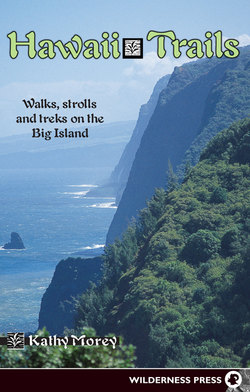Читать книгу Hawaii Trails - Kathy Morey - Страница 8
На сайте Литреса книга снята с продажи.
ОглавлениеGetting Information About the Big Island of Hawaii
The search for the perfect trail guide
I wish I could be certain this was a flawless book. However, some things limit an author’s ability to produce a perfect, error-free, always up-to-date book. Here are some of the factors, and what you can do to help yourself (and me).
Nature makes constant revisions; so do agencies
Nature constantly reshapes the landscape across which we plan to trek. That’s usually a gradual process, but once in a while she makes drastic changes overnight. A landslide or a volcanic eruption can erase a trail in seconds. Erosion can undercut a cliff edge and make last year’s safe hike an extremely dangerous one, so that the local authorities close a trail you’d hoped to ramble on. And Hawaii’s fragile volcanic terrain erodes quite rapidly.
Agencies in charge of hiking areas may close an area because they’ve realized it’s environmentally too sensitive to withstand more human visits. An area once open to overnight camping may become a day-use-only area. Trails become impassable from lack of maintenance. Happily, agencies may open new areas because they’ve been able to acquire new acreage or complete a trail-building project.
Change is the only thing that’s constant in this world, so that guidebook authors and publishers always play “catch up” with Nature and with agencies. We want to keep the guidebooks up to date, but we are always at least one step behind the latest changes. The day when you’ll have constantly revised books on-line at your wristwatch/computer terminal isn’t here yet. So it’s possible that a few trail descriptions are becoming obsolete even as this book goes to press.
Write for the latest information
It’s a good idea to use this book in conjunction with the latest information from the agency in charge of the areas you plan to hike in. Unfortunately, the recreation map of Hawaii published by the Hawaii District of the divisions of Forestry and Wildlife and of State Parks lacks trail information for hikers. The information it does have is quite out of date. There isn’t a better map available from those agencies. This book gives you a far more complete and detailed picture of Hawaii’s principal hiking and backcountry camping opportunities than the current recreation map does. And it describes those opportunities from a hiker’s perspective.
Still, it’s a good idea to write to these agencies as soon as you’ve read this book and decided where you want to hike and camp on Hawaii. Ask them for their latest trail and camping maps, regulations, and permit-issuing procedures. Except for Hawaii Volcanoes National Park, enclose a stamped, self-addressed envelope for your convenience in getting the information you need as soon as possible. (National parks almost always use the franking privilege of Federal agencies, so you’d be wasting a stamp.) Their addresses and telephone numbers are in “Getting Permits or Permission.”
Prepare yourself with general information, too. A generous source of a wide variety of useful information about Hawaii is the Hawaii Visitors Bureau at www.gohawaii.com; 2270 Kalakaua Avenue, Suite 801, Honolulu, HI 96815; info@hvcb.org; or 1-800-GOHAWAII (1-800-464-2924; U.S. and Canada only).
